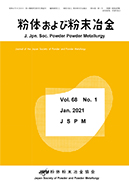
- |<
- <
- 1
- >
- >|
-
Yukihiro KANECHIKA2021Volume 68Issue 12 Pages 511-519
Published: December 15, 2021
Released on J-STAGE: December 15, 2021
JOURNAL OPEN ACCESSAluminum nitride (AlN) has high thermal conductivity and high electrical insulation, so it can be used as an insulating heat dissipating material. It is a material used in a wide range of fields such as power semiconductors, LED (Light-Emitting-Diode), LD (Laser-Diode) packaging substrates and semiconductor manufacturing equipment parts. It is mainly industrialized by two AlN powder manufacturing methods, the alumina reduction nitridation method and the Al direct nitridation method. AlN powder for fillers has been developed with characteristics in particle size and particle shape and manufacturing technologies such as new reduction nitridation method, combustion synthesis method and AlN sintering method. We have succeeded in developing various size AlN fillers from 1 to 120 μm and surface-treated products for resins used in TIM (Thermal-Interface-Material) of electronic devices.
This paper describes the AlN powder manufacturing technology and recent technological trends, the characteristics of AlN powder, the AlN ceramics sintering technology and its characteristics and the development of AlN heat dissipation filler.
View full abstractDownload PDF (2028K)
-
Kurima KOBAYASHI2021Volume 68Issue 12 Pages 523-535
Published: December 15, 2021
Released on J-STAGE: December 15, 2021
JOURNAL OPEN ACCESSThis paper reviews my research on the role of domain structures and domain wall motion, especially, in anisotropic sintered permanent magnets. The existence of domain wall motion in Nd–Fe–B sintered magnets during the intermediate stages of the demagnetization process has been revealed experimentally using the step method, susceptibility measurements of magnetically demagnetized samples, and direct Hall probe sensor measurements of flux densities in holes drilled in magnets. This evidence of multi-domain regions during demagnetization has shown that the magnetically reversed regions should be larger than several micrometers. To explain these experimental results, the critical size of the magnetic reversal center, which is a nanometer-sized nucleus, and the explosive growth of the nucleus to micrometer-sized reversed regions with volumes 105–106 times larger were discussed based on classical equations. Accordingly, the Stoner–Wohlfarth model, Kronmüller’s equation modified by considering the surface domain wall of the nucleus, and Becker’s model of growth of the reversal center were discussed. The phenomenological Ginzburg–Landau free energy curves were also determined for each case of magnetic reversal in the single-domain grain and in the saturable multi-domain grains in conjunction with the energy equations.
View full abstractDownload PDF (537K)
-
 Takeshi SAITO, Hideaki MATSUBARA, Yasuharu FUKUICHI, Taichi KAJIWARA2021Volume 68Issue 12 Pages 536-542
Takeshi SAITO, Hideaki MATSUBARA, Yasuharu FUKUICHI, Taichi KAJIWARA2021Volume 68Issue 12 Pages 536-542
Published: December 15, 2021
Released on J-STAGE: December 15, 2021
JOURNAL OPEN ACCESSJoined plates of WC-Co cemented carbides with different Co content, WC grain size and carbon content were fabricated by sintering, grinding into rectangular plates, and then reheating (joining) the two plates together. Distribution of Co, microstructure and shape of such joined plates were investigated in detail. It was confirmed that Co migrated from higher Co content to lower one, from coarser WC grains to finer ones and from higher carbon content to lower one as shown in previous studies by Lisovsky and Fang. Shapes of the joined plates were distorted caused by volume change of each plate resulting from migration of liquid Co and solute WC through the interface of the joined plates. In the joined plates with different Co content, Co distributed discontinuously at the interface. This result can be explained by the fact that Co content at the both sides of the interface had been almost fixed just after two faces were joined. This study was done under the special condition using joined plates, but the results obtained suggest that the shape of industrial-made WC-Co cemented carbides should be distorted when distribution of Co becomes non uniform.
View full abstractEditor's pick2021 JSPM Distinguished Paper Award
Download PDF (2337K)
-
2021Volume 68Issue 12 Pages Pref12_1-
Published: December 15, 2021
Released on J-STAGE: December 15, 2021
JOURNAL OPEN ACCESSDownload PDF (351K) -
2021Volume 68Issue 12 Pages Mtg12_2-Mtg12_5
Published: December 15, 2021
Released on J-STAGE: December 15, 2021
JOURNAL OPEN ACCESSDownload PDF (399K) -
2021Volume 68Issue 12 Pages Pref12_6-
Published: December 15, 2021
Released on J-STAGE: December 15, 2021
JOURNAL OPEN ACCESSDownload PDF (136K) -
2021Volume 68Issue 12 Pages 544-
Published: December 15, 2021
Released on J-STAGE: December 15, 2021
JOURNAL OPEN ACCESSDownload PDF (122K) -
2021Volume 68Issue 12 Pages Index68_1-Index68_9
Published: December 15, 2021
Released on J-STAGE: December 15, 2021
JOURNAL OPEN ACCESSDownload PDF (643K)
- |<
- <
- 1
- >
- >|